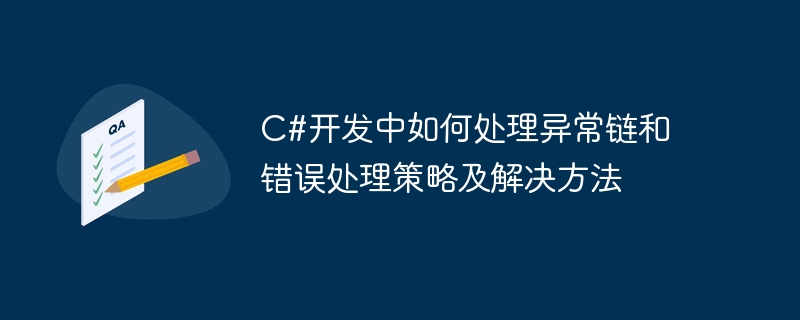

How to handle exception chains and error handling strategies and solutions in C# development
In C# development, exception handling is an important task, it can help us Troubleshoot program errors and improve program stability and robustness. Exception chaining is a common exception handling method that can capture and handle multiple exceptions and provide more detailed error information. This article will introduce how to handle exception chains and error handling strategies in C# development, and give specific code examples.
In C#, you can pass the inner exception object to a new exception object by using the exception constructor with inner exception parameters to form an exception chain. For example:
try
{
// some code
}
catch (Exception ex)
{
throw new CustomException("An error occurred.", ex);
}In the above example, when an exception is caught, an exception chain is formed by passing the original exception object ex to the constructor of the new CustomException exception object. In this way, where an exception is captured, the complete exception stack information can be obtained by accessing the StackTrace attribute of the internal exception.
try
{
// some code
}
catch (Exception ex)
{
Logger.Error(ex.Message);
}try
{
// some code
}
catch (ExpectedException ex)
{
// do nothing or just log the error
}try
{
// some code
}
catch (Exception ex)
{
int errorCode = -1; // define error code to indicate specific error
return errorCode;
}try
{
// some code that may throw exception
}
catch (Exception ex)
{
// log the exception
Logger.Error(ex.Message);
// throw a custom exception with inner exception
throw new CustomException("An error occurred.", ex);
}In In the above example, when an exception is caught, the exception information is first recorded in the log, and then the original exception is passed to the new CustomException object as an internal exception to form an exception chain. In this way, in the upper layer call, you can obtain the original exception information by accessing the InnerException property.
Summary:
In C# development, handling exceptions is an important task. By using exception chaining and appropriate error handling strategies, program stability and robustness can be improved. In actual projects, it is necessary to select appropriate exception handling methods according to specific situations, and use logging and other tools to trace the source of exceptions in order to better handle and solve problems.
The above is the detailed content of How to handle exception chains and error handling strategies and solutions in C# development. For more information, please follow other related articles on the PHP Chinese website!
 How to solve 0xc000409 error
How to solve 0xc000409 error
 How to solve the WerFault.exe application error
How to solve the WerFault.exe application error
 The difference between JD.com's self-operated flagship store and its official flagship store
The difference between JD.com's self-operated flagship store and its official flagship store
 The difference between get and post
The difference between get and post
 wayos soft routing
wayos soft routing
 Mango tv plug-in
Mango tv plug-in
 Convert text to numeric value
Convert text to numeric value
 Introduction to software development tools
Introduction to software development tools
 How to learn go language from 0 basics
How to learn go language from 0 basics




